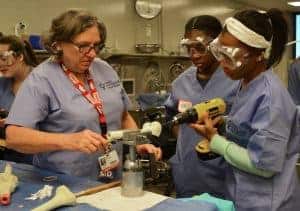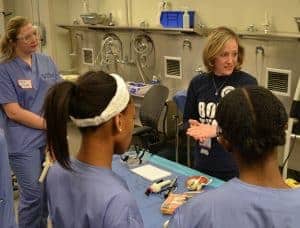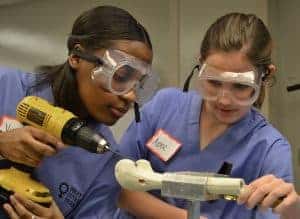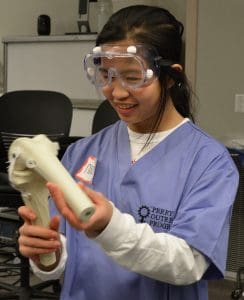Dec. 19, 2017 | Faces serious with concentration as drill bits spiral into bone. Faces protected by goggles as fragments start to fly. Faces that break into smiles and nervous laughter as they examine their first attempts at standard orthopaedic surgery techniques.
Faces that – unlike the trend for most of orthopaedic surgery and engineering disciplines – are female.
Twenty-five female high school students from Arkansas took part in a daylong, hands-on introduction to orthopaedics and engineering Dec. 9 as part of the Perry Outreach Program, held in UAMS’ Jackson T. Stephens Spine & Neurosciences Institute.

“It’s rewarding to see the girls come in at the beginning of the day, anxious as they try things, and to see them by the end of the day, when they grab the drill and just do it, with total confidence and problem solving — that is so powerful,” said Theresa Wyrick, M.D., a UAMS orthopaedic hand specialist.
The program is organized by the Perry Initiative, a national nonprofit that aims to increase the number of women in orthopaedics and engineering through programs with students in high school, college and medical school. This was UAMS’ seventh year to partner with the Perry Initiative for the program, which in some years also includes medical students.
Wyrick, who is also vice chair of the orthopaedic surgery and an associate professor in the College of Medicine’s Department of Orthopaedic Surgery, spoke in the morning to the students about work-life balance. Erin Mannen, Ph.D., director of orthopaedic research at UAMS and an assistant professor in the College of Medicine, spoke about her work engineering new methods for treating hip dysplasia. Kasa Cooper, an orthopaedic surgery resident, talked about the process of getting into medical school.
“Engineering and orthopaedics work hand-in-hand, because a lot of the innovations in orthopaedics come from engineering approaches to problem-solving,” said Ruth Thomas, M.D., an orthopaedic foot specialist, professor in the College of Medicine and director of UAMS’ Center for Foot and Ankle Surgery. “We need women to be contributing to medical advancement in these areas. For example, Dr. Mannen’s work in hip dysplasia may allow a baby to be treated for hip dysplasia while being carried close to mom. Women are needed in these fields for the betterment of our world.”

In the afternoon, Wyrick, Thomas, staff from the Perry Initiative and other women with an interest in orthopaedics from UAMS and across central Arkansas led the students through hands-on modules that included casting, suturing (on pigs feet), breaking a bone and repairing it (external fixation), reconstructing a torn knee ligament, repairing a rotator cuff and inserting an intramedullary nail. They worked with “bones” made of compressed sawdust that mimic the density and feel of real human bones.
While medicine in general has not always welcomed women, orthopaedics in particular has been slow to open up. Only 6 percent of fully accredited practicing orthopaedic surgeons in the United States are women.
Thomas was the only female in her residency group and spent much of her early career alone as well.

.
“I definitely think programs like these are making a difference,” Thomas said. “Both ortho and engineering are now wide-open fields for women, when that wasn’t always the case.”
UAMS is proud to be a part of this trend, not only by partnerships with organizations like the Perry Initiative, but by having a Department of Orthopaedic Surgery with a robust representation of females.
“The whole purpose is to show these girls that they can do it, that engineering and orthopaedics are fun,” Thomas said.
Wyrick said it feels special to her just to get the experience of participating.
“At the end of the day, it’s about empowering the girls to do what they want to do. Go out and do it,” Wyrick said. “This is what an orthopaedic surgeon looks like. We all look like orthopaedic surgeons now.”
Medtronic Inc., a global medical device company, provided a $5,000 sponsorship for the program. The UAMS Graduate School provided lunch for the participants.

